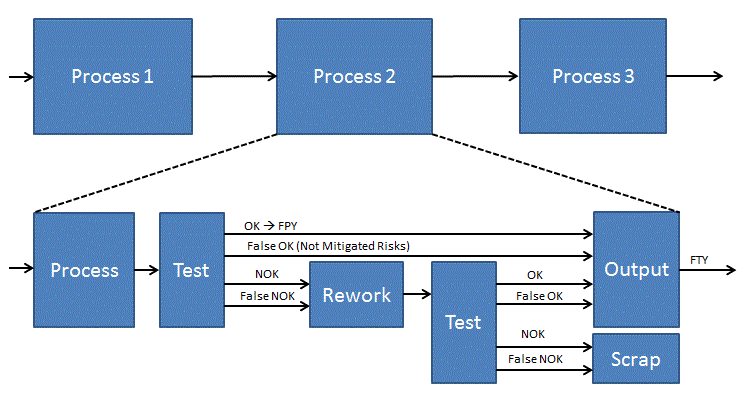Movip
Yield Definitions
Yield
- Yield
- First Time Yield (FTY)
- First Pass Yield (FPY) or Throughput Yield (TPY)
- Rolled Throughput Yield
- Final Yield (FY)
- Normalized Yield (NY)
First Time Yield (FTY)
Example:
- 100 systems enter the first process, 90 leaves the first process. FTY = 90%
- 90 systems enter the second process, 72 leaves the second process. FTY = 80%
- 72 systems enter the third process, 72 leaves the third process. FTY = 100%
72 systems leaves the process as good which results in a First Time Yield (FTY) 72%

Due to the not ideal test some systems are flagged OK while not meeting the good criteria. These False OK are the not mitigated risk not covered by he test.
First Pass Yield (FPY) or Throughput Yield (TPY)
Example:
- 100 systems enter first process, 85 leaves the process without rework and 5 leave the process with rework. FPY = 85%
- 90 systems enter second process, 72 leaves the process without rework and 0 leave the process with rework. FPY = 80%
- 72 systems enter the third process, 60 leaves the third process without rework and 12 leave the process with rework. FPY = 83%
72 systems leaves the process as good with a First Pass Yield (FPY) 56.6%
How to determine the good systems is done by testing the output of the process.

After Test we can identify four output streams:
- OK or First Pass Yield
- False OK
- NOK
- False NOK
Each applied test is not perfect in finding the good systems. An example could be that a functional test is applied which can find if the system is working but not checks if all fasteners are handled according specification. Be aware that a test must cover all risks added in the process.
OK or First Pass Yield (FPY)
OK or First Pass Yield (FPY) represents all the systems are tested good and where all the added risks from the process are found.
False OK
With a false Ok the test is not covering all risks and gives an OK. The test has not the 100% coverage needed to identify good systems. These false OK's can result in a defect later on in the following processes or a life time issue later on.
NOK
A NOK system failed the test. Based on the result this can be reworked and tested again. Here the same four output streams are possible. A reworked system passes the test is not added to the First Pass Yield (FPY) but to the First Time Yield (FTY). Reworked systems posses a quality risk due to the extra steps/repairs. A large difference between First Pass Yield (FPY) and First Time Yield (FTY) should result in a process improvement.
False NOK
A False NOK is a good system but tested NOK. A posibility is that the test has parameteres which have a to tight window which results in a False NOK. This is unneccesary loss.
After Rework and tested NOK systems are scraped. With a high scrap rate the process step posses a risk in output (logistics, planning, tool utilazation, cost, ...).
Rolled Throughput Yield (RTY)
Example:
- 100 systems enter first process, 15 defects are counted (in 10 systems). RTY = 85%
- 90 systems enter second process, 27 defects are counted (in 18 systems). RTY = 70%
72 systems leaves the process as good with a Rolled throughput Yield (FPY) 59.5%
The Rolled throughput yield gives a better insight in the number of defect and is a more consistent measure of the process than the First Pass Yield.
Final Yield (FY)
Example:
- 100 systems enter first process, 72 leaves the process. FY = 72%
Normalized Yield (NY)
A note of caution: This metric can be misleading if the throughput yields of the process steps vary a great deal.